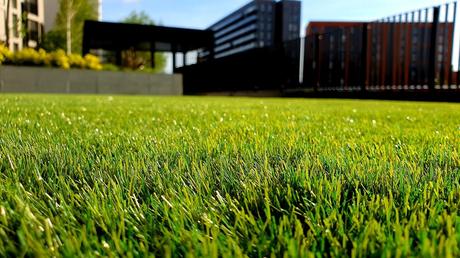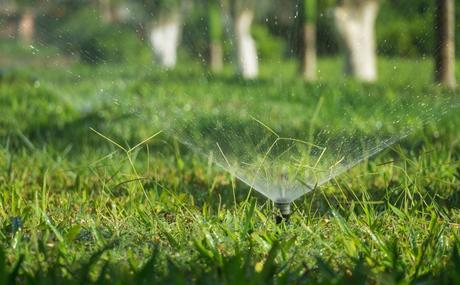Maintaining a beautiful, healthy lawn is an essential aspect of homeownership. A well-kept lawn not only provides a fantastic space for recreation and relaxation but also adds value to your property. Proper lawn maintenance goes beyond just cutting the grass; it requires diligence and care. Here are 10 essential lawn maintenance tips to help you achieve the perfect lawn to enjoy all season long.

Photo credit: Unsplash
Mowing your lawn regularly encourages healthy growth by removing damaged and diseased grass, ultimately allowing healthy blades to thrive. When cutting the grass, ensure that you do not remove more than 1/3 of the grass height in a single session.
Cutting too short, especially during hot weather, can lead to scalping and contribute to a shallow root system, making it less resilient against drought, pests, and disease.
Adjust your mower's height and mow on a schedule that promotes a grass height of 3-4 inches for best results. If you've got issues with your lawn mower, make sure to consult this Kohler starter solenoid wiring diagram.
A sharp blade is essential when mowing your lawn. Dull blades tear the grass instead of cutting it, increasing the risk of disease and reducing the lawn's drought resistance.
Sharpen the mower blades at least twice a season for a clean cut. In addition, vary your mowing pattern and direction to avoid soil compaction and encourage the healthy growth of grass blades.
Soil compaction can hinder the development of grassroots and result in an unhealthy lawn. Aeration involves creating small holes in the soil to allow air, water, and nutrients to reach the grassroots.
Homeowners should aerate their lawn at least once a year, ideally during the spring or fall when the grass is actively growing. There are various tools available for aerating, from manual aerators to motorized machines that can be rented from gardening stores.
Proper watering is crucial for developing a robust root system for your lawn. Many homeowners either water too often or too little, leading to shallow root systems or drought stress. As a general rule, lawns need about 1 to 1.5 inches of water per week, either from rain or supplemental watering.
Water your lawn deeply and infrequently to encourage deep root growth. Water in the morning to minimize evaporation and allow the grass to dry before nightfall, reducing the risk of disease.

Photo credit: Pexels
Regular fertilization provides your lawn with essential nutrients, promoting healthy growth and increasing resistance against pests and diseases. Choose a slow-release fertilizer and apply it in the spring, summer, and fall to support the growth and overall health of your lawn. Be careful not to over-fertilize, as excessive nutrients can harm grass and pollute local water sources.
Weeds are unsightly and compete with desirable grasses for nutrients, water, and sunlight. Prevent weeds from taking hold in your lawn by maintaining healthy grass through proper mowing, watering, and fertilization practices.
If weeds do appear, address them promptly through hand-pulling or using a specialized tool for precision removal. For persistent weed problems, consider using a selective herbicide designed to control weeds without harming grass.
Over time, lawns may develop bare spots or thin areas from foot traffic or pest damage. Overseeding involves adding grass seed to an existing lawn, improving density and restoring a lush appearance. The best time to overseed is in the fall, as the cool soil and ample moisture provide ideal conditions for seed germination. Be sure to choose a seed that matches your existing grass species and follow the recommended application rates for optimal results.
Grass thrives in soil with a balanced pH level of 6.5 to 7.0. When pH levels are too high or too low, grass struggles to absorb nutrients, resulting in a lackluster appearance and reduced vigor. Test your soil's pH and adjust as needed by adding lime for acidic conditions or sulfur for alkaline soil. Perform a soil test every two years to monitor pH levels and maintain a healthy lawn all year round.
Pests such as grubs, chinch bugs, and sod webworms can wreak havoc on a lawn and cause significant damage. Early detection and swift action can prevent an infestation from becoming a more significant issue. Monitor your lawn regularly for signs of pests or diseases and address them promptly with appropriate treatments, such as insecticides or natural pest control options.
Leaves, twigs, and other debris can smother grass and promote disease if left unattended. Use a rake or leaf blower to clear debris from your lawn regularly, especially in the fall.
In addition, avoid allowing heavy objects or furniture to remain stationary on your lawn for extended periods, as this can cause compaction and inhibit growth.
Achieving a healthy and attractive lawn takes time, effort, and a commitment to proper maintenance practices. By following these 10 essential tips, homeowners can cultivate a lush and inviting outdoor space to enjoy for years to come.
Remember that a well-maintained lawn benefits not only your property value but also the environment, as healthy grass plays an essential role in filtering pollutants and producing oxygen.
